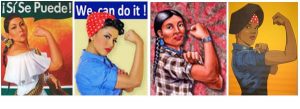
100 Years of Dominican Feminisms was a lecture that Ginetta Candelario, a Dominican sociologist, gave that provides insight into the true origins of feminism and its development within the Dominican Republic. Her argument and research has led her to find that feminism in its earliest forms began with Mercedes Mota, She was chosen by her sisters to attend the International Council of Women in Buffalo and represent the Dominican Republic along with a few other women. This began the journey and process of women becoming empowered and defining themselves as women. She inspired other Dominican women to achieve equality in all facets of the word and in the process own the title feminist. This movement is less investigated and known and Candelario seeks to retrace the steps of feminist thought and history.
It was very moving to hear Professor Ginetta Candelario describe her 10 years of arduous and intense research methods to discover and unearth the truth about feminism. As a Dominican woman, her passion and interest was apparent as presented her findings throughout her lecture. I did not once question her knowledge on the subject because she was quite receptive to the audience’s questions and explained the ambiguities of the story of feminism well. Candelario provided a long and detailed account of the many instrumental figures that helped provide the foundation for future feminist. The only critique I had about the lecture was that it was longer than expected and Candelario over explained when giving an answer to a question. I wasn’t able to ask her my questions and it was a bit frustrating. Overall, I would say that this lecture was informative and well executed.
Dr. Candelario clearly relates to our readings and course very poignantly as we read her book Black Behind the Ears: Dominican Racial Identity from Museums to Beauty Shops. Her work attempts to assess and describe how a Beauty Shop can create community for Dominicans. It is because each member of the community are looking out for one another. In this section we are studying the Dominican Republic and their past and current race relations. We see that there was a dislike for “blackness” in the Dominican Republic and it continues today. The progress of the Dominican Republic are marred by the Rafael Trujillo’s rule in the 20th century and still influence racial relations for Dominicans even outside the country. Racial segregation continues to exist, but in different and obscure ways. Widespread segregation within beauty shops and other races goes unquestioned. Identity remains the main challenge for many Dominicans as it was changed during the Trujillate and now with the migration to the U.S., Dominicans are having to redefine themselves yet again.
It seems that barber shops are providing outlets for these challenges, while at the same time harboring anti-blackness sentiment in subtle and overt ways. In what ways does the evolving Dominican sense of identity bring about unity amongst other Dominicans, and in what ways does it divide and exclude others?
